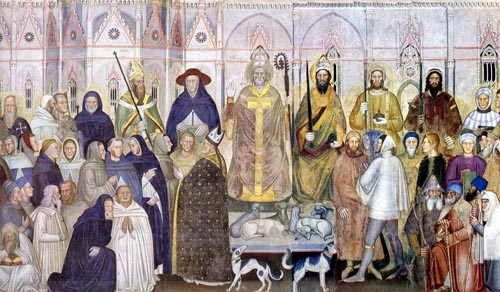 |
The Saint of the Day
Pope St. Gregory VII, May 25
Prof. Plinio Corrêa de Oliveira
Biographical selection:
St. Gregory VII, Pope and Confessor. By his teachings and action he affirmed and defended the rights of the Pope over the Church, and of the spiritual over the temporal sphere. He was an example of intransigence, courage, and confidence in the supernatural.
Comments of Prof. Plinio:
It’s a pity that I didn’t remember to bring here a document attributed to St. Gregory VII that is attacked by all the progressivist theologians. It is called Dictatus Papae (1090), which means the The Dictates of the Pope. It is a kind of summary he dictated of the theses he wanted to uphold. Among those theses, one of the most beautiful and habitually shunned regards the relation between the Pope and the Emperor as head of the temporal sphere.
The Emperor at the time, Henry IV, was intervening in Church matters in order to direct her through the control of the election of the Bishops. St. Gregory VII fought against this. He wanted to smash this pretension of the imperial government and humiliate it, and in fact he did so.
The Dictatus Papae shows his thinking on the relations that should exist between the Holy Roman Empire and the Papacy. He affirmed that the Papal Monarchy is a universal monarchy in spiritual matters. In temporal matters the Papal Monarchy should decisively influence the Empire, even without governing it directly. The temporal power should be the sword of the Pope, at his service to protect the Holy Catholic Church, defend the Faith, and persecute its enemies. The temporal power should govern its subjects independently according to natural law, but the Papacy should watch over how this is done. There would be two different and independent powers.

The Papacy as the center of society was established in the Middle Ages after the victory of St. Gregory VII over the pretensions of the Emperor. In the picture, the latter is at the right of and one step lower than the Pope
|
Which one would be the highest power? At the top is the Pope, and at his left, one step down is the Emperor, and below the Emperor, all the Kings and sovereigns of the temporal sphere. Also below the Pope and to his right is the entire Catholic Hierarchy in the spiritual sphere. In synthesis, everything relies upon the Pope. This was St. Gregory VII’s conception of the two powers.
We might ask St. Gregory VII on his feast day to intercede for the world so we might again have this conception of the spiritual and temporal orders. On the day when this again becomes the general view, it will be the dawn of the Reign of Mary. The reverse is also true: on the day that the dawn of the Reign of Mary will arrive, this vision will be born with it.
Let us pray to St. Gregory VII to move God to bring back his sublime vision on earth, because without it nothing can find the right path.


  | | Prof. Plinio Corrêa de Oliveira | |
The Saint of the Day features highlights from the lives of saints based on comments made by the late Prof. Plinio Corrêa de Oliveira. Following the example of St. John Bosco who used to make similar talks for the boys of his College, each evening it was Prof. Plinio’s custom to make a short commentary on the lives of the next day’s saint in a meeting for youth in order to encourage them in the practice of virtue and love for the Catholic Church. TIA thought that its readers could profit from these valuable commentaries.
The texts of both the biographical data and the comments come from personal notes taken by Atila S. Guimarães from 1964 to 1995. Given the fact that the source is a personal notebook, it is possible that at times the biographic notes transcribed here will not rigorously follow the original text read by Prof. Plinio. The commentaries have also been adapted and translated for TIA’s site.
|
Saint of the Day | Home | Books | CDs | Search | Contact Us | Donate

© 2002- Tradition in Action, Inc. All Rights Reserved
|
 |
|